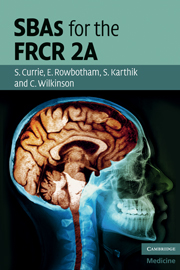Book contents
- Frontmatter
- Contents
- List of contributors
- Preface
- Introduction
- Module 1 Cardiothoracic and vascular
- Module 2 Musculoskeletal and trauma
- Module 3 Gastro-intestinal
- Module 4 Genito-urinary, adrenal, obstetrics & gynaecology and breast
- Questions
- Answers
- Module 5 Paediatric
- Module 6 Central nervous and head & neck
- References
- Index
Answers
Published online by Cambridge University Press: 06 July 2010
- Frontmatter
- Contents
- List of contributors
- Preface
- Introduction
- Module 1 Cardiothoracic and vascular
- Module 2 Musculoskeletal and trauma
- Module 3 Gastro-intestinal
- Module 4 Genito-urinary, adrenal, obstetrics & gynaecology and breast
- Questions
- Answers
- Module 5 Paediatric
- Module 6 Central nervous and head & neck
- References
- Index
Summary
1. c. Adenomyosis
Adenomyosis is a focal or diffuse benign invasion of myometrium by endometrium, which incites reactive myometrial hyperplasia. It is associated with endometriosis (20–40%). It typically presents in multiparous women in the late reproductive years. Symptoms include pelvic pain, menorrhagia and dysmenorrhea, although adenomyosis it may be an incidental finding.
Adenomyosis may be diffuse or focal. Ultrasound appearances are variable but usually there is slight enlargement of the uterus with loss of homogeneity of the myometrium. There may be pseudo-widening of the endometrium due to increased myometrial echogenicity. MRI is more specific and demonstrates thickening of the junctional zone. When diffuse, a widened low-intensity junctional zone >12 mm confirms the diagnosis whereas <8 mm excludes the disease. For indeterminate sizes, further findings may aid the diagnosis, such as high-signal-intensity linear striations extending out from the endometrium into the myometrium on T2 and high signal foci on T1 – representing ectopic endometrial tissue/haemorrhagic foci.
When focal (adenomyoma), there is typically an oval/elongated mass with ill-defined margins residing within the myometrium which is in continuity with the junctional zone. Distinction from leiomyomas may be difficult but these tend to be round, sharply marginated masses occurring anywhere in the myometrium and they may contain calcifications.
(Refs: Dahnert p. 1028, p. 1068; Grainger & Allison p. 1225)
- Type
- Chapter
- Information
- SBAs for the FRCR 2A , pp. 88 - 100Publisher: Cambridge University PressPrint publication year: 2010



